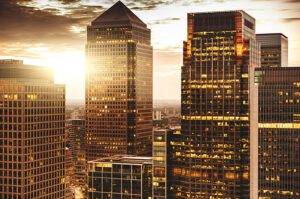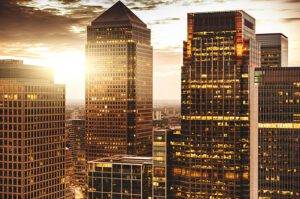Turn empty London offices into nightlife hotspots, says new leisure report


The future of Canary Wharf and the City of London may be less about spreadsheets and more about sound systems, according to a bold new proposal to revive both the capital’s financial districts and its embattled nightlife sector.
Creative studio Bompas & Parr has suggested that London’s underused office blocks—left increasingly vacant due to the post-pandemic shift to hybrid working—could be transformed into “world-class late-night party zones”, offering a bold reimagining of urban space in the capital.
The idea forms part of the studio’s annual trend report on the future of leisure, which paints a vivid picture of financial centres reborn after dark. “By day, the city bustles with suits and stocks. By night, it’s reborn as a pulsating rave arena,” the report declares.
With few residential buildings in districts like the City, where only 8,500 people live compared to 500,000 workers, the report argues that noise complaints—a longstanding headache for club operators—would be minimal. Empty lobbies, rooftops and boardrooms could host DJs, light shows and dancefloors, creating a “sprawling web of passionate chaos as capitalism and counterculture merge”.
While the concept might sound fanciful, it’s gaining serious attention from stakeholders in the hospitality sector.
Michael Kill, chief executive of the Night Time Industries Association (NTIA), confirmed that conversations are already under way about how to breathe new life into these areas, particularly given that financial districts now see peak activity only three days a week.
“What we’ve always had with the financial districts is, after a Friday night, they close down and everyone disappears,” Kill explained. “But now we’re seeing people only work from the office for about three days a week. Friday has become an extension of the weekend. So landlords are obviously looking for new opportunities, and that is a very constructive conversation we’re having.”
Kill said current discussions include exploring how zoning and planning rules might be adapted to offer preferential treatment for nightlife operators, encouraging clubs and hybrid venues to set up in these central areas.
The NTIA has repeatedly warned that the UK’s nightlife sector faces extinction by 2029 if current trends continue. Between 2013 and 2024, the number of nightclubs more than halved, with the pandemic accelerating closures across the country.
But the industry is adapting. From “light clubbing” and conference-friendly venues to all-night dance floors, operators are evolving to meet changing consumer demand—and demographics.
Bompas & Parr believes the over-50s market represents a significant opportunity. “The generation that pioneered sex, drugs, and rock’n’roll” is now seeking new ways to spend its free time, the report argues.
Kill agrees, noting that older revellers are often the ones keeping clubs afloat: “What we’ve seen is the industry, in many respects, has been propped up by an older generation that are plugged into revisiting those club culture memories, rave memories, events memories. The reality is, all they want to do is go out and revisit their youth.”
With commercial landlords looking to repurpose empty space, and nightlife venues in need of new, affordable homes, this unexpected alliance between finance and festivals could yet offer a lifeline to both sectors—and reinvent London’s late-night identity in the process.
Read more:
Turn empty London offices into nightlife hotspots, says new leisure report





